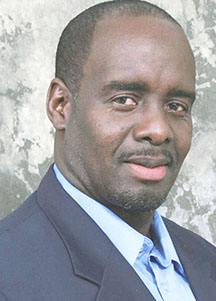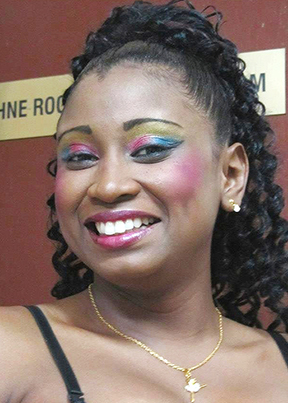A play, Brixton Stories by Biyi Bandele, was performed at the Theatre Guild Playhouse recently under special circumstances. This production, directed by Jude Idada, was brought from where it was being performed in Canada for staging in Guyana by Desiree Edghill for Artistes in Direct Support, and had the collaborative support of the Department of Culture in Guyana.
 It is an uncomplicated drama, but not the straightforward type, requiring careful handling by the director to make it work at all – moreso to give it some life and spectacle and make it understandable and interesting for the audience. It is basically a narrative, reminiscent of a short story or novella – a work of fiction dramatised with dialogue. In this case, a fairly Spartan script pushed the director to seek strategies to lift it into compelling and engaging theatre.
It is an uncomplicated drama, but not the straightforward type, requiring careful handling by the director to make it work at all – moreso to give it some life and spectacle and make it understandable and interesting for the audience. It is basically a narrative, reminiscent of a short story or novella – a work of fiction dramatised with dialogue. In this case, a fairly Spartan script pushed the director to seek strategies to lift it into compelling and engaging theatre.
The cast in the Guyanese production featured John Phillips and Sonia Yarde, who carried the play as Ossie Jones and his daughter Nehusha, with Desiree Edghill as the DJ. Phillips is an actor who started his career in the GuySuCo Head Office Drama Festival before being recruited by the Theatre Company and thereafter becoming a leading actor. He made his impact in a range of several plays as well as in The Link Show. After many years in the limelight, he moved to Canada where he continued his career in Canadian productions and films. He returned to Guyana with the director Idada for the local performance of this play. Yarde, foremost local prize-winning actress, director and playwright, joined them, as did Edghill, who managed and produced the show.

The drama centres around Ossie Jones who reunites with his now grown up daughter Nehusha after he has spent 15 years in a coma in a hospital. By this time his wife, the mother of Nehusha, has died and the man tries to readjust to life, to a new family situation. He has to connect not only with his daughter who is by now a stranger to him, but also with a changing society, and with reality. This elusive reality is central to the plot since Jones is still conscious of dreams from his long comatose sleep. This visitation from the sub-conscious seems to play a role in the working of Jones’ conscious reality although it does not interfere with the apparent plot or become evident to the audience until the end of the play. And even there, it is only a suggestion.
If the playwright had made more of this faint element and made it matter to what unfolds in the long narrative it would have strengthened the play. As it was Brixton Stories was a dramatic narration delivered by Jones with dialogue, action and a play within a play interspersed.
The lead actors were highly competent and strove to keep the interest of the audience throughout. They understood the demands of a performance that called for switches in delivery since as Jones tells the story it is acted out by the two protagonists. Phillips had to carry this, moving in and out of story-teller and character in a sort of stream of consciousness and reflection. This involved giving a personality to Jones. What Phillips managed well was the communication of alienation and self-consciousness evident in a man coming out of a very unusual situation and tentatively trying to reclaim a normal life.
Yarde supported him very well and succeeded in playing the daughter who is very conscious – perhaps over-conscious – of her role as guide to her father, at times over-trying to behave as if everything was normal and act away the vacuum of his 15-year absence and the strange circumstances of it. The value of her sensitive acting came over in the role of a daughter trying hard to not make her father feel alienated and almost pretending as if it was business as usual.
She was not fazed by stops and starts of acting out what was being narrated, and in fact both performers handled that seamlessly. It was affected by a little bit of really trying too hard, as they tended to overdo the displays of affection. Their constant inability to let go, clinging to each other at every conceivable moment became a bit superfluous.
There were obstacles that the actors had to overcome. First was the script, which was somewhat overburdened by words. To state it differently is difficult: it was wordy. Not only were there lengthy passages of narrative, but the language was somewhat verbose and weighty, giving the audience much to listen to and less to see.

Perhaps that is why there were so many interludes, mostly of music and dancing, to break it up a bit. These were, however, not very deep and seemed to be there just for some variety to punctuate the talking. In most cases music was played – mostly reggae: Marley; and there was quite a generous helping of dancing. Yet this dancing was not choreographed, made no statement and was not even interesting. There was no intention to be artistic; people just bounced to the music. The third character in the play was the DJ (Edghill), whose role was very limited and little meaning could be drawn from when she descended occasionally to join the dancing – skanked around a bit and returned to her place upstage.
The most meaningful of these interludes was the play within the play. Yet it was simply that the girl took her father to see a play and they acted out a sample of it. The actors managed that well, becoming the two characters in the play they were watching. Stretching the imagination a little, one could discern a connection between the emotional issues plaguing the father and daughter, and those confronting the characters in the play they saw.
However, the significance of the other intrusions was fairly elusive, if they had purposes other than monotony breakers. What is more, the director admits this in the Programme Notes. “The set design is Spartan in a replication of the obtuse essence of the play and the use of contemporary music, dazzling lighting and sound effects have been lavish, in order to reduce the ‘cerebral’ nature of the play . . .” that attempt was obvious, except the audience never quite got the “dazzle” of the light and sound effects.
The set was not “Spartan” as the director described it and probably intended it to be. On the contrary, there was probably too much furniture, such as the two beds, and spaces that were under-used.
Idada further claims that the play is set in “a dystopian world situated in the low income and multicultural town of Brixton;” and that the two main characters “immerse themselves in the startling peculiarities of the neighbourhood.” But he had “acclimatised” it “to the Guyanese experience, so as to connect it with the audience and their own realities.”
It is a British play, although coming to Guyana from the Canadian stage. It is set in Brixton, from which it takes its title. But “Brixton Stories” is only a name. The play did not have a sense of place. Brixton is a large South London community, (in)famous for its volatile inner city reputation, its black and West Indian population, race issues and riots of the past. While those do not exhaust the totality of Brixton one does not get the feel of it, or of anywhere else in the play. The setting seemed important to the drama as suggested by the title and the director’s notes, but it played a very minimal role in the plot and the presentation.
Those, and that the play “opens the door to the world of magical realism” are some of the expectations given to the audience by the director. If, by “magical realism” he was referring to the fictional explorations with which Gabriel Garcia Marquez and Wilson Harris are associated, none of it could be discerned in the play, its script or production.
One came away from Brixton Stories with the feel of a play that was not all that was expected of it. Despite the credible performances, the director did not manage to put together a play that sufficiently realised his considerable and ambitious vision to the audience.




